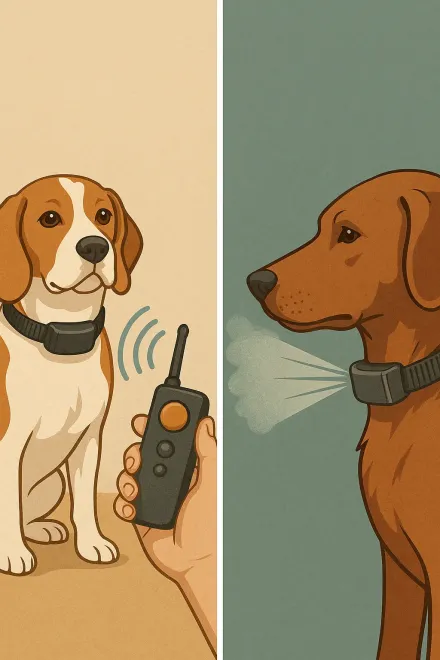No-Shock Dog Training Collar
The no-shock dog training collar, also known as a humane training collar, is a gentle alternative that helps teach and correct unwanted behaviors using non-invasive, pain-free stimuli. These devices rely on signals such as vibrations, beeps, or, in some cases, harmless air or spray bursts to get the dog's attention without causing discomfort.
They are ideal for owners looking for a kinder training method, as well as for sensitive dogs or small breeds that might become stressed with more intense collars. They are widely used in positive reinforcement training, combining the stimulus with rewards to encourage desired behaviors.
When used correctly, this type of collar can help reduce excessive barking, prevent escapes, improve obedience, and stop dangerous behaviors—while ensuring the dog's comfort and well-being.
View No-Shock Dog Training Collars on Amazon
How Does a No-Shock Dog Training Collar Work?
A no-shock dog training collar works by delivering a safe, non-painful stimulus when the dog performs an undesired behavior. The stimulus can be a vibration, an audible beep, or a short burst of air or harmless spray, such as citronella.
The device includes a receiver worn around the dog's neck and can be activated manually via a remote control, or automatically, as in anti-bark collars that detect sound.
Many models allow adjustment of intensity or duration to match the dog's temperament and size, ensuring an effective and comfortable training experience.
Benefits of Using a No-Shock Dog Training Collar
Choosing a no-shock dog training collar offers multiple advantages, especially for those prioritizing positive reinforcement:
- Humane training: corrects unwanted behaviors without causing pain or excessive stress.
- Versatile stimuli: choose between vibration, sound, or spray depending on what works best for your dog.
- Ideal for sensitive dogs: suitable for small breeds, puppies, or nervous dogs.
- Safe training: avoids the physical risks associated with more invasive methods.
- Positive reinforcement-friendly: can be combined with treats and praise for better results.
The main advantage is that it respects the dog's well-being while improving obedience and behavior.


Types of No-Shock Dog Training Collars
There are several types of no-shock collars available, each suited to different training needs:
- Vibration collars: deliver short or intermittent vibrations to capture the dog's attention.
- Sound collars: emit an audible beep to signal the dog to stop an action.
- Spray collars: release a harmless burst of air or scented spray (like citronella) that the dog finds unpleasant.
- Multi-mode collars: combine vibration, sound, and spray in one device for greater flexibility.
The best choice depends on your dog's personality, the behavior you want to address, and your training style.
Frequently Asked Questions About No-Shock Dog Training Collars
Are no-shock collars effective?
Yes, especially when combined with positive reinforcement techniques. They are designed to safely interrupt unwanted behaviors like excessive barking, jumping, or disobedience.
At what age can I start using one?
Generally from 6 months old, once the dog has basic physical and mental development. For younger puppies, focus on positive reinforcement and basic commands.
Are they suitable for all breeds?
Yes, but choose a model suited to your dog's size and weight. Small dogs need lighter collars with softer stimuli, while larger dogs can handle sturdier models.
Can they help reduce barking?
Yes, especially automatic models that detect barking and trigger vibration, sound, or spray. However, addressing the root cause of barking is recommended for lasting results.
Are they safe for dogs?
Yes, when using a quality product as directed. They do not cause pain or harm, only mild stimuli to capture the dog's attention.
How long does the battery last?
It depends on the model and usage. Some last several days with heavy use, while others can last over two weeks with moderate use.
